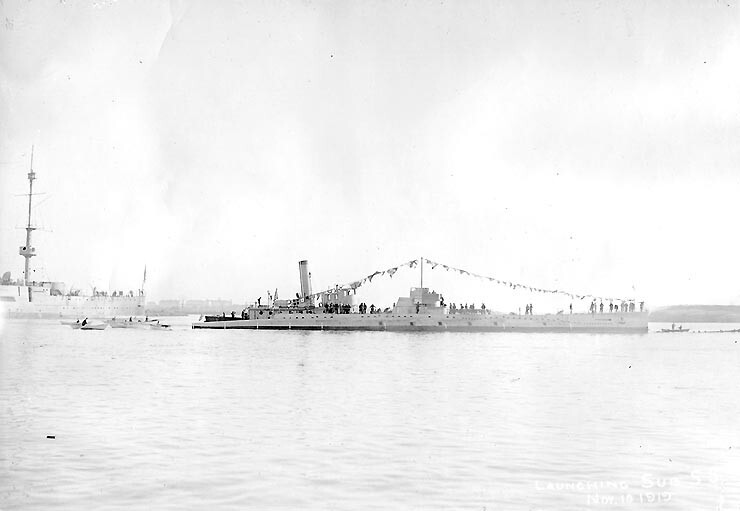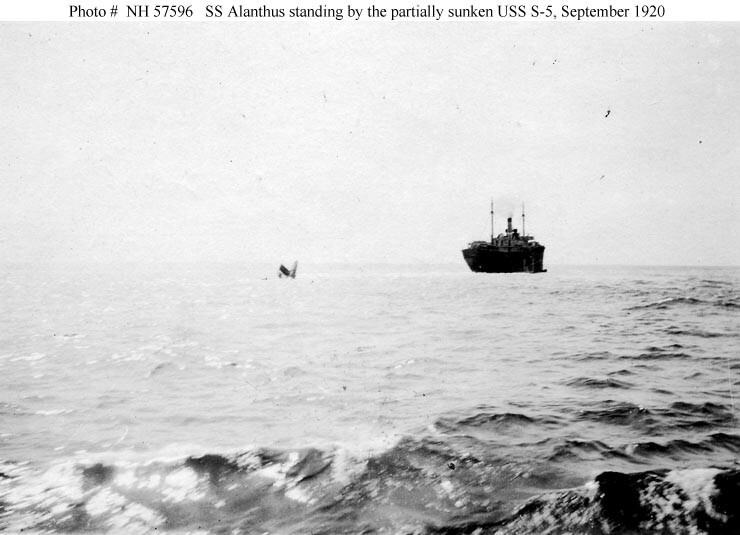Hell by Compass A sudden decision that saved the lives of submariners (5 photos)
Any disaster at sea is much worse than on land. A hostile element, even without bad weather, leaves little chance of salvation. An endless ocean to the horizon and a sinking ship - this inspires horror and a feeling of hopelessness. Many died on the water even within sight of the shore, let alone the open ocean... 
USS S-5 (SS-110) shortly after launch, photographed November 10, 1919
But far more terrible is death at depth, under the water column, in the steel hull of a submarine. However, sometimes, when death seemed inevitable, fate intervened, granting people truly miraculous salvation.
The interwar period required a serious modernization of the fleet in all countries that considered themselves maritime powers in one way or another. A war, and especially a world war, always introduces many innovations in military affairs and accelerates the arms race. The new combat weapon - the submarine - showed its best side, which means that most of the naval powers sought to acquire them, and preferably of better quality than those of their competitors. The United States did not stand aside, and despite the crisis, the military budget was adopted, and new submarines rolled off the stocks. One of them was USS S-5, launched on November 10, 1919. The submarine had a length of 70 meters, a displacement of 890 tons, and carried four 533-mm torpedo tubes and a 100-mm cannon.
On August 30, 1920, the brand new S-5, after passing factory tests, crew training and completion of all internal work, left Boston to undergo running tests. On September 1, the boat was practicing an emergency dive scheduled for 13.00. However, one of the team members made a mistake while performing the necessary procedures and did not close the required valve in time. This led to the flooding of several compartments and the submarine listing to starboard. The uncoordinated actions of the team led to the fact that it became impossible to close some valves due to the pressure of water, and they only managed to leave the compartments filled with water. As a result, the boat took approximately 75 tons of water into the torpedo compartment and began to list on its bow.
After the incident, the commander ordered the ballast tanks to be blown out and returned to full capacity, but this turned out to be impossible, since one of the electric motors was filled with water and it failed. And soon the second one also failed - it also shorted due to liquid ingress. Following this, the crew tried to blow out the flooded compartments using a high-pressure centrifugal pump, then using a large low-pressure pump, but they also failed one after another. The situation was becoming hopeless. There were no means for rescue from depth at that time; they were invented and introduced into the submarine’s equipment much later, and the chances of detecting a submarine at such a depth were slim. 
Diagram of internal compartments S-5
Nevertheless, a solution was found, although it seemed crazy at first. The stern of the boat was slightly higher than the flooded bow. An idea was put forward: using controlled flooding and air pumping, raise the stern of the submarine up so that it was above the water. There were also disadvantages here - after all, water could flood even damaged batteries, which would lead to the release of chlorine and the death of the entire crew. The team got down to business. The stern tanks were purged, and then the water was drained from the engine compartment, resulting in the S-5's hull standing almost vertically. Tapping on the hull showed that the stern of the submarine rose six meters above the water. However, the nearest hatch from which the team could evacuate was still about 9 meters under water. It was decided to make a hole in the body, the thickness of which reached 19 millimeters. At 20.00 the team began drilling the body from the inside, using a hand drill, hammer and chisel. The work was hard and time-consuming, and the team, working in shifts, managed to make a hole measuring 15x20 centimeters by 14.00 the next day. By this time, people were already suffering from excess carbon dioxide, and the hole made was not enough for proper ventilation. Fortunately for the submariners, they noticed some kind of ship through the hole, and in order to attract attention, they inserted a three-meter pipe with a piece of clothing tied to it into the hole. This ship turned out to be the old steamer "Ailanthus", which was making its last voyage before being decommissioned. The captain of the ship at first mistook what he saw for a buoy, but, realizing that it could not possibly be here, he decided to check the mysterious object. At the stern of the submarine rising above the water, a very remarkable conversation took place, which has become partly legendary:
- What ship?
- S-5.
- What nationality?
- American
-Where are you going?
- Hell according to the compass.
(English):
- What ship?
- S-5.
- What nationality?
- American.
- Where bound?
- Hell by compass. 
"Alanthus" near the stern of the sunken S-5. Photo September 2, 1920
The old steamship could not help with widening the hole in the submarine - there were no tools for this, but they managed to install a pump on it to supply air inside the boat, transfer fresh water and food to the sailors inside, and tie ropes around the stern rising above the water to hold it in place. There was no radio on the Alantus either, but at 18.00 he managed to use signal flags to contact the passing steamship USS General G.W. Goethals, who in turn relayed the message to the US Navy. Naval engineers got to work, and by 01:45 on September 3, they had widened the hole enough for people to squeeze through. At 03.00, the submarine commander was the last to leave the ship. The entire crew survived and no one was injured.
On the morning of the same day, the battleship USS Ohio (BB-12) approached the stern of the submarine, which was still sticking out above the water, and, tying the boat with cables, tried to tow it. However, after four miles the cables broke, and the long-suffering S-5 sank to the bottom completely. 
A piece of the S-5 hull, cut by engineers at USS General G.W. Goethals." Now on display at the Washington Navy Yard Museum. The diameter of the piece is about 60 centimeters
The history of the S-5 is remarkable in many ways. Starting from the almost hopeless situation in which the crew found themselves due to the human factor, and to the decision to raise the stern of the boat above the water. And the main thing is that there are no casualties. This is one of the few cases of rescue of the entire crew of an emergency submarine, especially at a time when there were practically no rescue systems from a sunken ship.























